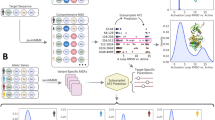Abstract
RAPID, transient induction of the human c-fos proto-oncogene by extracellular signals requires the presence in els of the serum response element (SRE)1,2. Two protein factors that bind to the SRE in vitro are the serum response factor (p67SRF)3—5 and polypeptide p62 (ref. 6). These polypeptides must interact with one another and the SRE for efficient serum induction of the c-fos gene6. Here we use dimethyl sulphate genomic footprinting7 to establish the in vivo protein contacts on the SRE and flanking sequences. In human A431 cells the patterns of protection and hyper-reactivity that we find are consistent with the presence of p67SRF, p62, and at least one other protein immediately 3' to p67SRF. The protein-DNA contacts we observe within the SRE are present before induction by epidermal growth factor and are unchanged during gene activation and subsequent repression. Our results indicate that a specific DNA—protein architecture may be maintained at the c-fos SRE, regardless of changes in the transcriptional state of the gene. Such established structures could be important generally in rapid transcriptional responses to extracellular signals.
This is a preview of subscription content, access via your institution
Access options
Subscribe to this journal
Receive 51 print issues and online access
$199.00 per year
only $3.90 per issue
Buy this article
- Purchase on Springer Link
- Instant access to full article PDF
Prices may be subject to local taxes which are calculated during checkout
Similar content being viewed by others
References
Shaw, P. E., Hipskind, R. A., Schröter, H. & Nordheim, A. in Nucleic Acids and Molecular Biology Vol. 3, 120–132 (Springer, Heidelberg, 1989).
Treisman, R. Cell 42, 889–902 (1985).
Treisman, R. Cell 46, 567–574 (1986).
Prywes, R. & Roeder, R. G. Molec. cell. Biol. 7, 3482–3489 (1987).
Schröter, H., Shaw, P. E. & Nordheim, A. Nucleic Acids Res. 15, 10145–10158 (1987).
Shaw, P.E., Schröter, H. & Nordheim, A. Cell 56, 563–572 (1989).
Church, G. M. & Gilbert, W. Proc. natn. Acad. Sci. U.S.A. 81, 1991–1995 (1984).
Jones, N. C., Rigby, P. W. J. & Ziff, E. B. Genes Dev. 2, 267–281 (1988).
Sassone-Corsi, P., Sisson, J. C. & Verma, I. M. Nature 334, 314–319 (1988).
Wilson, T. & Treisman, R. EMBO J. 7, 4193–4202 (1988).
Schönthal, A. et al. Oncogene (in the press).
Hayes, T. E., Kitchen, A. M. & Cochran, B. H. Proc. natn. Acad. Sci. U.S.A. 84, 1272–1276 (1987).
Bravo, R., Burckhardt J., Curran, T. & Müller, R. EMBO J. 4, 1193–1197 (1985).
McKnight, J. L. C., Kristie, T. M. & Roizman, B. Proc. natn. Acad. Sci. U.S.A. 84, 7061–7065 (1987).
Bender, A. & Sprague Jr. G. F. Cell 50, 681–691 (1987).
Bell, S. P., Learned, E. M., Jantzen, H.-M. & Tjian, R. Science 241, 1192–1197 (1988).
Becker, P. B., Gloss, B., Schmid, W., Strähle, U. & Schütz, G. Nature 324, 686–688 (1986).
Zinn, K. & Maniatis, T. Cell 45, 611–618 (1986).
Thomas, G. H. & Elgin, S. C. R. EMBO J. 7, 2191–2201 (1988).
Mueller, P. R., Salser, S. J. & Wold, B. Genes Dev. 2, 412–427 (1988).
Prywes, R. & Roeder, R. G. Cell 47, 777–784 (1986).
Jackson, P. D. & Felsenfeld, G. Proc. natn. Acad Sci. U.S.A. 82, 2296–2300 (1985).
Becker, P. B., Ruppert, S. & Schütz, G. Cell 51, 435–443 (1987).
Maxam, A. M. & Gilbert, W. Meth. Enzym. 65, 499–560 (1980).
Weih, F., Stewart, A. F. & Schütz, G. Nucleic Acids Res. 16, 1628 (1988).
Current Protocols in Molecular Biology (eds Ausubel, F. M. et al.) (Greene, New York, 1987).
Dignam, J. D., Lebovitz, R. M. & Roeder, R. G. Nucleic Acids Res. 11, 1475–1489 (1983).
Author information
Authors and Affiliations
Rights and permissions
About this article
Cite this article
Herrera, R., Shaw, P. & Nordheim, A. Occupation of the c-fos serum response element in vivo by a multi-protein complex is unaltered by growth factor induction. Nature 340, 68–70 (1989). https://doi.org/10.1038/340068a0
Received:
Accepted:
Issue Date:
DOI: https://doi.org/10.1038/340068a0
This article is cited by
-
Frequent copy number gains at 1q21 and 1q32 are associated with overexpression of the ETS transcription factors ETV3 and ELF3 in breast cancer irrespective of molecular subtypes
Breast Cancer Research and Treatment (2013)
-
ELK1
AfCS-Nature Molecule Pages (2011)
-
MAP kinases and the control of nuclear events
Oncogene (2007)
-
Cloning and characterization of the human gene RAP2C, a novel member of Ras family, which activates transcriptional activities of SRE
Molecular Biology Reports (2007)
-
Mitogen regulated induction of FRA-1 proto-oncogene is controlled by the transcription factors binding to both serum and TPA response elements
Oncogene (2005)
Comments
By submitting a comment you agree to abide by our Terms and Community Guidelines. If you find something abusive or that does not comply with our terms or guidelines please flag it as inappropriate.



